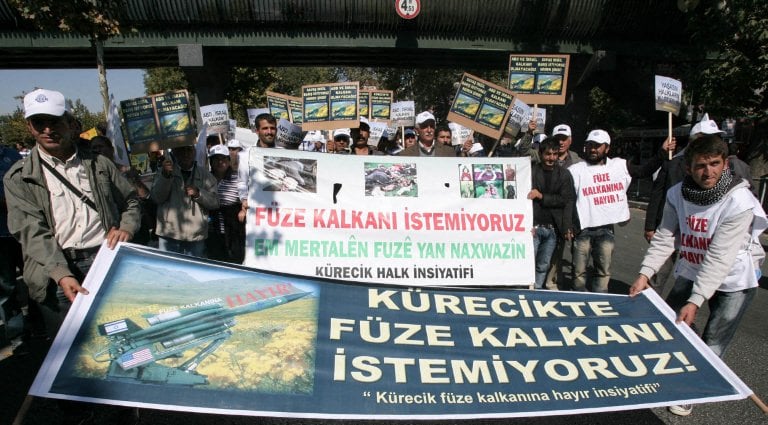Bünyamin Tekin
As missiles fly between Israel and Iran in their most dangerous confrontation to date, attention is turning to a high-tech radar system located in eastern Turkey.
The US-operated AN/TPY-2 radar installation in Kürecik, Malatya province, is capable of detecting missile launches from deep inside Iranian territory, and experts say it could play a critical role in warning against Iranian attacks.
The radar, operational since 2012, is part of NATO’s ballistic missile defense architecture. It was deployed to provide early warning of potential threats from Iran aimed at Europe. But its strategic positioning — roughly 500 kilometers from Iran’s western border with Turkey — also makes it highly valuable to any system trying to intercept Iranian missiles midflight.
Kürecik is not the closest radar to Iran and not the only radar capable of detecting Iranian launches, but it is strategically positioned to offer among the earliest tracking of missiles launched from Iran’s western regions. There are other US-operated radars, like the ones in Israel and Qatar.
Officially, Turkey and NATO deny that any data from the Kürecik radar is shared with non-NATO countries. Turkish authorities reiterated that position in a public statement over the weekend, calling the suggestion that Israel could access radar data “black propaganda” and warning that such claims could constitute a criminal offense under Turkish law.
“The data obtained from the Kürecik radar base is exclusively shared with NATO allies within a specific framework, in accordance with NATO procedures,” the government’s communications directorate said.
But defense analysts note that while NATO cannot share information with Israel, the radar is operated by US forces, and the data it gathers is transmitted through a US-controlled battle management network. Once the information enters the US command system, it can be shared through bilateral US–Israel military channels — making it technically possible for Israel to benefit from radar data collected on Turkish soil.
Retired Lt. Gen. İsmail Hakkı Pekin, the former head of Turkish General Staff Intelligence, claimed Kürecik is used to defend Israel during a recent television appearance.
Speaking on CNN Türk, Pekin stated that three missiles launched from Yemen toward Israel were intercepted midair by US warships using intelligence gathered from radar systems at both Malatya’s Kürecik base and in Israel. “These American air defense ships receive direct warnings via radar,” Pekin said. “One is our Kürecik radar in Malatya, the other is in Israel. The data is sent to the command center at Ramstein and then relayed to the ships, which shoot the missiles down.”
Since launching strikes on Iranian military sites late last week, Israel has come under sustained ballistic missile fire from Iran, including attacks on Tel Aviv, Haifa and Jerusalem. At least eight civilians have been killed, and air-raid sirens continue to disrupt daily life. In Tehran, Israeli strikes killed more than 200 civilians, have triggered mass evacuations, panic buying and fuel shortages.
US forces in the region, including warships in the eastern Mediterranean and fighter jets, are helping reinforce Israel’s missile defense. But the radar network feeding those defenses remains opaque. What is clear is that Kürecik provides early tracking data to the US missile defense system, which includes space-based sensors, Aegis ships, THAAD batteries and land-based interceptors. Through that network the United States can alert its allies to incoming missile threats in real time.
Israeli defense forces have not publicly commented on whether they are receiving data linked to the Kürecik radar. The Israeli military relies on its own US-built X-band radar located in the Negev Desert, which also monitors Iran’s airspace, but at a greater distance than Kürecik.
Veli Ağbaba, a member of parliament from the main opposition Republican People’s Party (CHP) from Malatya province, warned this week that Turkey’s radar infrastructure may be used against the government’s stated policy.
“You denounce Israeli attacks, but say nothing about Kürecik. Everyone knows this radar gives early warning about missiles from Iran. So who is it really protecting?” he said in a statement calling for the radar to be shut down.
The Turkish government has rejected such claims. Yet the nature of the Kürecik radar — integrated into overlapping NATO and US missile defense networks — makes it almost impossible to verify where the data ultimately goes.
Former Turkish diplomat Mustafa Enes Esen told Turkish Minute that the Kürecik radar has always been framed as part of NATO’s collective missile defense shield, not a bilateral project with the United States.
According to Esen, Turkey demanded political assurances that data collected at Kürecik would be shared only with NATO allies. “That remains the official line — repeated by NATO, by US officials, and by Ankara. The radar may be owned by the US, but its mission is tied to NATO’s ballistic missile defense. Publicly, there’s no ambiguity: Non-NATO countries do not receive this data,” he said.
In Esen’s view the idea that Kürecik provides a uniquely decisive edge is overstated. “Yes, it’s well positioned to track launches from Iran, but it’s not the only radar that can do that. The US has radars in Israel and at its bases and military installations in the region. From a military standpoint, there are alternatives. Kürecik is important — but not irreplaceable,” he said.
For now, the radar continues to scan Iranian airspace from a hilltop in Malatya. It is not publicly known whether the information it collects is reaching Israeli defense systems. But in a region now bracing for further escalation, a key early warning system lies inside a NATO ally that officially opposes the Israeli aggression.

